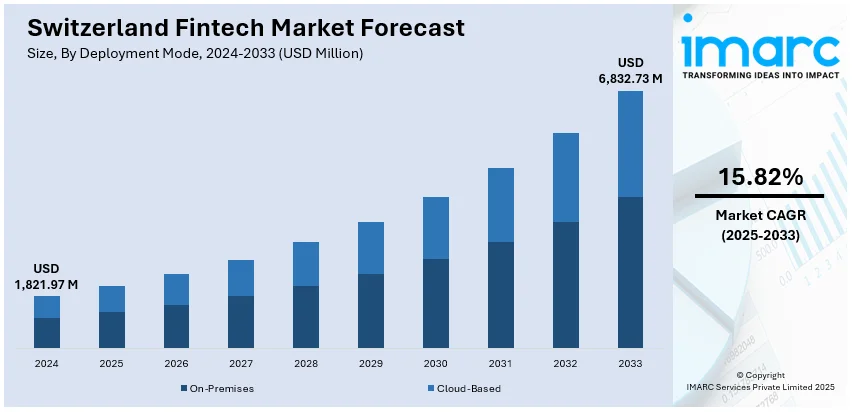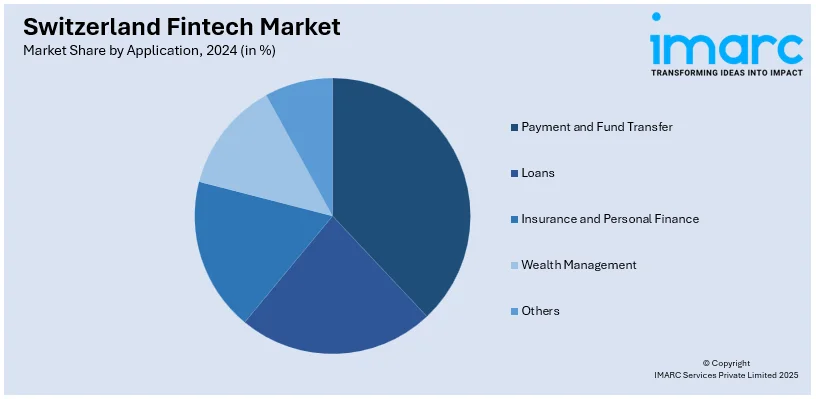
Switzerland Fintech Market Size, Share, Trends and Forecast by Deployment Mode, Technology, Application, End User, and Region, 2025-2033
Switzerland Fintech Market Overview:
The Switzerland fintech market size reached USD 1,821.97 Million in 2024. The market is projected to reach USD 6,832.73 Million by 2033, exhibiting a growth rate (CAGR) of 15.82% during 2025-2033. The market is experiencing robust growth, driven by increasing digital adoption, innovation in financial services, and supportive regulatory frameworks. Key trends include the rise of AI, blockchain integration, and mobile banking solutions, reshaping how consumers and institutions interact with finance. Deployment modes, applications, and user preferences continue to diversify, enhancing competitiveness across the sector. As technology evolves and demand for streamlined financial solutions increases, the industry is poised for sustained development. These factors collectively influence the Switzerland fintech market share.
|
Report Attribute
|
Key Statistics
|
|---|---|
|
Base Year
|
2024
|
|
Forecast Years
|
2025-2033
|
|
Historical Years
|
2019-2024
|
| Market Size in 2024 | USD 1,821.97 Million |
| Market Forecast in 2033 | USD 6,832.73 Million |
| Market Growth Rate 2025-2033 | 15.82% |
Switzerland Fintech Market Trends:
Expanding B2B Horizons and Global Reach
Swiss fintech companies are increasingly pivoting toward business-to-business services and global clients, reflecting a shift toward resilience and scale in an otherwise saturated domestic environment. Rather than pursuing high-profile consumer apps, many are building robust infrastructure solutions think streamlined ESG reporting, interoperable payment rails, and analytics platforms geared for institutional users. It's a smart turn: B2B models offer repeatable revenue, deeper integration, and clearer value propositions. In March 2025, an authoritative survey confirmed that most Swiss fintech’s now prioritize B2B over consumer offerings. That strategic move isn’t just about survivalists positioning for long-term leadership. It also highlights how Switzerland fintech market trends are being shaped by clarity of purpose and adaptability. FinTech’s are becoming trusted partners to established systems rather than disruptors for disruption’s sake. It feels like a sector growing up not retreating. And in that maturity lies optimism, a landscape guided by sustainable business logic tends to be more enduring and impactful than one chasing headlines.

To get more information on this market, Request Sample
Digital Maturity and Market Saturation
Switzerland's fintech sector is changing gears from record expansion to a more cautious, quality-focused phase. This transition can be seen in the manner that companies are redefining priorities, prioritizing sustainable value over quick fixes. The industry, previously characterized by incessant launches of new initiatives, is now typified by refinement and consolidation. Long-established players are reinforcing core propositions, while newer players are navigating an increasingly competitive, regulated landscape. In December of 2024, the landscape showed this new balance: innovation continues to be robust, but it occurs in a more discerning, mature context. This change is promising for long-term resiliency, indicating that businesses are prioritizing scalable models over pursuing growth at any cost. Meanwhile, sustainability continues to drive direction, with more companies trending towards green finance ambitions and long-term regulatory currents. These strides aren’t retreats; they are indications of stability and strategic concentration. In general, the Switzerland fintech market growth narrative today is less about the number of new startups and more about how effectively the ecosystem adapts, matures, and creates lasting influence.
Regulation as a Catalyst for Purpose
Swiss fintech’s aren’t just adapting to new rules they’re evolving because of them. The push toward climate-aligned reporting and strategic planning has shifted regulatory changes from obligations into opportunities for differentiation. At the same time, the Swiss Federal Council’s consultation on enhancing climate disclosures signals that transparency and accountability are becoming fundamental requirements rather than optional features. This shift prompts firms to embed sustainability into governance, reporting, and product design, not just as ethical branding but as operational reality. FINMA and the SNB are also stepping up: under revised rules effective January 2025, they’re now required to assess climate-related risks for supervised institutions bringing green considerations into the heart of oversight. Instead of regulatory burden, there’s a growing sense that regulation is a framework for smart, responsible innovation. Fintech’s are responding by embedding environmental responsibility into their DNA, which enhances credibility and paves the way for long-term relevance. Ultimately, regulatory clarity is fueling creativity and turning the sector into a place where innovation and integrity go hand in hand.
Switzerland Fintech Market Segmentation:
IMARC Group provides an analysis of the key trends in each segment of the market, along with forecasts at the country and regional levels for 2025-2033. Our report has categorized the market based on deployment mode, technology, application, and end user.
Deployment Mode Insights:
- On-Premises
- Cloud-Based
The report has provided a detailed breakup and analysis of the market based on the deployment mode. This includes on-premises and cloud-based.
Technology Insights:
- Application Programming Interface
- Artificial Intelligence
- Blockchain
- Robotic Process Automation
- Data Analytics
- Others
The report has provided a detailed breakup and analysis of the market based on the technology. This includes application programming interface, artificial intelligence, blockchain, robotic process automation, data analytics, and others.
Application Insights:

- Payment and Fund Transfer
- Loans
- Insurance and Personal Finance
- Wealth Management
- Others
A detailed breakup and analysis of the market based on the application has also been provided in the report. This includes payment and fund transfer, loans, insurance and personal finance, wealth management, and others.
End User Insights:
- Banking
- Insurance
- Securities
- Others
A detailed breakup and analysis of the market based on the end user has also been provided in the report. This includes banking, insurance, securities, and others.
Regional Insights:
- Zurich
- Espace Mittelland
- Lake Geneva Region
- Northwestern Switzerland
- Eastern Switzerland
- Central Switzerland
- Ticino
The report has also provided a comprehensive analysis of all the major regional markets, which include Zurich, Espace Mittelland, Lake Geneva Region, Northwestern Switzerland, Eastern Switzerland, Central Switzerland, and Ticino.
Competitive Landscape:
The market research report has also provided a comprehensive analysis of the competitive landscape. Competitive analysis such as market structure, key player positioning, top winning strategies, competitive dashboard, and company evaluation quadrant has been covered in the report. Also, detailed profiles of all major companies have been provided.
Switzerland Fintech Market News:
- August 2025: Thredd has become the first issue processor to enable real‑time payment control for travel agencies using the Mastercard Wholesale Programme. Through flexible product codes, clients can instantly adjust virtual card payments based on supplier requirements such as location, product type, and volume enhancing visibility, adaptability, and control in B2B travel transactions. Developed for the dynamic needs of the travel sector, this advancement improves security and predictability in cross‑border payments while optimizing cost and efficiency
- August 2025: Switzerland has benefit from the increased cooperation between Baidu and Lyft in striving to introduce self-driving ride-hailing services in Europe. While Germany and the UK are the entry points for now, Switzerland's leading infrastructure and innovative culture position it well for eventual rollout. Merging Baidu's leading-edge autonomous vehicle technology, Lyft's platform of operations, and its European footprint, this partnership can help define Switzerland's mobility services and more.
Switzerland Fintech Market Report Coverage:
| Report Features | Details |
|---|---|
| Base Year of the Analysis | 2024 |
| Historical Period | 2019-2024 |
| Forecast Period | 2025-2033 |
| Units | Million USD |
| Scope of the Report |
Exploration of Historical Trends and Market Outlook, Industry Catalysts and Challenges, Segment-Wise Historical and Future Market Assessment:
|
| Deployment Modes Covered | On-Premises, Cloud-Based |
| Technologies Covered | Application Programming Interface, Artificial Intelligence, Blockchain, Robotic Process Automation, Data Analytics, Others |
| Applications Covered | Payment and Fund Transfer, Loans, Insurance and Personal Finance, Wealth Management, Others |
| End Users Covered | Banking, Insurance, Securities, Others |
| Regions Covered | Zurich, Espace Mittelland, Lake Geneva Region, Northwestern Switzerland, Eastern Switzerland, Central Switzerland, Ticino |
| Customization Scope | 10% Free Customization |
| Post-Sale Analyst Support | 10-12 Weeks |
| Delivery Format | PDF and Excel through Email (We can also provide the editable version of the report in PPT/Word format on special request) |
Key Questions Answered in This Report:
- How has the Switzerland fintech market performed so far and how will it perform in the coming years?
- What is the breakup of the Switzerland fintech market on the basis of deployment mode?
- What is the breakup of the Switzerland fintech market on the basis of technology?
- What is the breakup of the Switzerland fintech market on the basis of application?
- What is the breakup of the Switzerland fintech market on the basis of end user?
- What is the breakup of the Switzerland fintech market on the basis of region?
- What are the various stages in the value chain of the Switzerland fintech market?
- What are the key driving factors and challenges in the Switzerland fintech market?
- What is the structure of the Switzerland fintech market and who are the key players?
- What is the degree of competition in the Switzerland fintech market?
Key Benefits for Stakeholders:
- IMARC’s industry report offers a comprehensive quantitative analysis of various market segments, historical and current market trends, market forecasts, and dynamics of the Switzerland fintech market from 2019-2033.
- The research report provides the latest information on the market drivers, challenges, and opportunities in the Switzerland fintech market.
- Porter's five forces analysis assist stakeholders in assessing the impact of new entrants, competitive rivalry, supplier power, buyer power, and the threat of substitution. It helps stakeholders to analyze the level of competition within the Switzerland fintech industry and its attractiveness.
- Competitive landscape allows stakeholders to understand their competitive environment and provides an insight into the current positions of key players in the market.
Need more help?
- Speak to our experienced analysts for insights on the current market scenarios.
- Include additional segments and countries to customize the report as per your requirement.
- Gain an unparalleled competitive advantage in your domain by understanding how to utilize the report and positively impacting your operations and revenue.
- For further assistance, please connect with our analysts.
 Request Customization
Request Customization
 Speak to an Analyst
Speak to an Analyst
 Request Brochure
Request Brochure
 Inquire Before Buying
Inquire Before Buying




.webp)




.webp)












